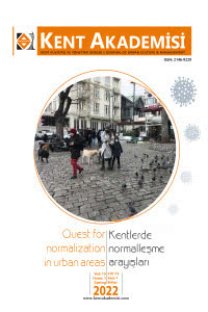Kamusal/Kentsel İç Mekânda Yer Kimliğinin Bir Bileşeni Olarak ‘Anlam’ın Önemi: Kızlarağası Hanı, İzmir
Kamusal erişim ve kullanım sahibi birçok iç mekân, kentin günlük yaşamına dahil oldukları için kamusal olarak kabul edilir. Kentsel bir çevrede yer kimliği, ortam elemanları, faaliyetler ve etkinliklerin yanı sıra anlamlarla karakterize edilir. Bu makalenin amacı, kamusal ve kentsel iç mekânı yer kimliğinin bir bileşeni olarak anlam açısından incelemek, anlam özelliklerinin ve unsurlarının iç mekânların kimliğini nasıl etkilediğini belirlemektir. Bu doğrultuda makale söz konusu mekânlardaki anlamın önemini ve yer kimliğinin sürekliliği üzerindeki yansımalarını açıklığa kavuşturmaktadır. Bir örnek olay incelemesi olarak bu araştırma, İzmir’in tarihî merkezi ve çarşı bölgesi olan Kemeraltı Çarşısı’ndaki Kızlarağası Hanı’nı yarı açık bir kamusal iç mekân ve yakın çevresini kentsel iç mekânlar olarak kabul etmektedir. Kamusal ve kentsel iç mekân göstergeleri ile anlamı arasındaki ilişkileri belirlemek için Kızlarağası Hanı ve yakın çevresine ait veriler analiz edilmiştir. Veriler; gözlem, fotoğraf çekimi, davranış haritaları gibi alan çalışmalarının yanı sıra anketler ve mülakatlar ile temin edilmiştir. Çalışmanın bulguları, kamusal ve kentsel iç mekânlardaki yer kimliği oluşumunun hem fiziksel hem de sosyal çevre ile ilişkisi olduğunu göstermektedir. Daha ayrıntılı tanımlamalar vermek gerekirse, mekân kimliğinin inşasında insanların duyusal deneyimleri, bağlılıkları, katılımları, hatıraları ve yere ait niyetleri aracılığıyla oluşturulan bireysel ve grup anlamlarının tümü etkili olmaktadır.
Anahtar Kelimeler:
Kamusal iç mekân, kentsel iç mekân, mekân kimliği, anlam, Kızlarağası Hanı
The Importance of 'Meaning' as a Component of Place Identity in Public/urban Interiors: Kızlarağası Inn, İzmir
Many interior spaces in cities, freely available to all citizens, are classified as public because they belong to people. Interiors are a part of the public spaces where urban culture is formed, and socio-spatial change is observed, and they have an important place in the formation of the identity of the place. In an urban setting, meanings as well as spatial components, events, and activities, which are the values that make the identity of the place unique, are a distinctive feature. This research investigates the qualities and elements of meaning, which is a component of place identity, and its effects on interior identity in the context of public/urban interiors. Thus, the importance of meaning and its effects on spatial identity are explained in more detail. In the study, as a case analysis, the Kızlarağası Inn, located in İzmir Kemeraltı Bazaar, was determined as a semi-open public interior, and its immediate environs surroundings as an urban interior. Data obtained through fieldwork, surveys and interviews were analyzed to determine the combination of meanings and indicators of public/urban interiors. As a result of the study, it has been seen that physical and social environments are effective in the formation of place identity in public/urban interiors. In summary, people’s sensory experiences that create individual and group meanings, attachments, place-related intentions, and memories are effective in the formation of place identity.
Keywords:
Public interior, urban interior, place identity, meaning, Kızlarağası Inn,
___
- Başarır, S. B. (2015). Urban interior: Taksim square and Cumhuriyet Street underpass [Unpublished master’s thesis]. İstanbul Technical University.
- Brown, A. (2006). Contested space: Street trading, public space, and livelihoods in developing cities, ITDG.
- Department of Architecture TU Delft. (2016). Architecture of the interior. https://www.tudelft.nl/en/architecture-and-the-built-environment/about-the faculty/departments/architecture/organisation/groups/architecture-of-the-interior/
- Ersoy, B. (1991). İzmir hanları. Atatürk Kültür Merkezi Yayınları.
- Harteveld, M. (2006). Viva Las Vegas. A search for the urban design task of interior public space. In V. D. Hoeven, and H.J. Rosemann (Eds.), Urban Transformations and Sustainability. Progress of Research Issues in Urbanism 2005 (pp. 33–41). Delft University Press.
- Harteveld, M. (2014). Interior public space. Human space. https://humanspace.weblog.tudelft.nl/interior-public-space/
- Harteveld, M. (2014). Interior public space on the mazes in the network of an urbanist [Doctoral dissertation]. Delft University of Technology. https://doi.org/10.4233/uuid:d594e36a-560b-4559-bc5b-85dc3b83be02.
- Dokumen.tips (2021). İzmir meeting planner's guide. https://dokumen.tips/documents/izmir-meeting-planners-guide-2012.html
- Madanipour, A. (2003). Public and private spaces of the city. Routledge.
- Montgomery, J. (1998). Making a city: Urbanity, vitality and urban design. Journal of Urban Design, 3(1), 93–66. https://doi.org/10.1080/13574809808724418
- Özbek Sönmez, I. (2010). The urban historical stratum of the Kemeraltı Bazaar. In A. E. Göksu, and Ş. Gökçen Dündar (Eds.), Urban Historical Stratum: from Smyrna to İzmir, 120-128, İzmir: Dokuz Eylül University.
- Poot, T., Van Acker, M., and De Vos, E. (2015). The public interior: The meeting place for the urban and the interior. Idea Journal, 15, 44–55. https://doi.org/10.37113/ideaj.vi0.52
- Relph, E. (1976). Place and placelessness. Pion.
- Seamon, D., Sowers, J. (2008). Place and placelessness (1976): Edward Relph. In P. Hubbard, R. Kitchin, and G. Valentin, Key Texts in Human Geography (pp. 43–52). Sage Publications.
- Şala, D. (2013). Evaluation of urban design guidelines in the context of urban identity (İzmir- Kemeraltı Historical Center) [Unpublished master's thesis]. Mimar Sinan Fine Arts University.
- Ujang, N., and Zakariya, K. (2015). The notion of place, place meaning and identity in urban regeneration. Procedia - Social and Behavioral Sciences, 170, 709–717. https://doi.org/10.1016/j.sbspro.2015.01.073
- White, E. T. (1999). Path, portal, place: Appreciating public space in urban environment. Architectural Media Ltd.
- ISSN: 2146-9229
- Yayın Aralığı: Yılda 4 Sayı
- Başlangıç: 2008
- Yayıncı: Karadeniz Yazarlar ve Şairler Derneği
Sayıdaki Diğer Makaleler
Türkiye Medyasının 2021 Yazı Yangınlarını Haberleştirmesi
Kent, Mekân, Sınır ve Kimlik: Türkiye’de Kentsel Kimliklerin İnşasında Kentsel Sınırların Rolü
Rusya Federasyonu Hukukunda Mültecilere İlişkin Düzenlemeler
Haluk TANRIVERDİ, Kartal Doğukan ÇIKI
Türk Konut Piyasası Yeni Şeklini Nasıl Alıyor?
Kentleşme Bağlamında Sokak Hayvanlarının Değişen Statüsü
Kentsel Bir Fragman Olarak Kapalı Konut Yerleşmeleri: Kayseri Örneği
